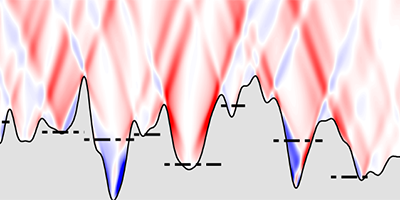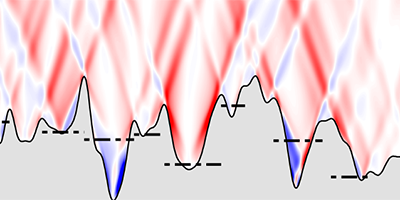Motion in the Ocean
The Earth’s climate is strongly affected by the ways in which energy moves into, out of, and around the oceans. One important component of energy flow is the conversion of tidal motion—changes in sea levels caused by gravitational effects of the Moon—into internal ocean waves. Such waves directly influence mixing of water from regions with different temperature and salinity, as well as overall circulation. In a paper in Physical Review Letters, Likun Zhang and Harry Swinney at the University of Texas at Austin, present numerical simulations of how tidal flow over seafloor ridges is transformed into wave energy. They find that only the topmost parts of seafloor topography contribute to wave generation, in effect creating a “virtual seafloor.” It is only above it that tidal energy can be converted to wave energy.
The efficiency of tidal-to-wave energy conversion is difficult to calculate owing to the complex structure of the seafloor: When sea levels rise and fall, water moves up and down on top of underwater mountains and ridges; the vertical motion of the sea bounces off the slopes of these topographic features to create sideways oscillations that form a complex structure of internal ocean waves. Zhang and Swinney carried out simulations on both sinusoidal and random seafloor topographies and discovered that, some distance below the peaks of these structures, no conversion takes place. The reason is that wave interference cancels out tidal-to-internal energy conversion below this virtual seafloor. As a result, the authors suggest that future simulations of this important process can be simpler and more accurate because any topography below the virtual seafloor can be ignored. – David Voss





